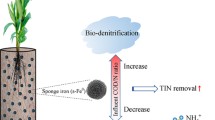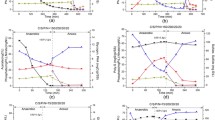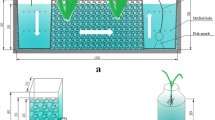Abstract
High concentration of nitrogen and phosphorus and imbalance of N/P can lead to the formation of water and the malignant proliferation of toxic microalgae. This study put forward the advanced nutrient removal with the regulation of effluent N/P as the core in order to restrain the eutrophication and growth of poisonous algae. According to the preliminary study and review, the optimal N/P for non-toxic green algae was 50:1. The horizontal sub-surface flow constructed wetland was filled with steel slag and ceramsite to achieve the regulation of effluent N/P. The results showed that steel slag had the stable P removal capacity when treating synthetic solution with low P concentration and the average removal rate for 1.5, 1.0, and 0.5 mg/L synthetic P solution was 2.98 ± 0.20 mg kg−1/h, 2.26 ± 0.15 mg kg−1/h, and 1.11 ± 0.10 mg kg−1/h, respectively. Combined with P removal rate and P removal task, the filling amount of steel slag along the SSFCW (sub-surface flow constructed wetland) was 3.22 kg, 4.24 kg, and 4.31 kg. In order to ensure the stability of dephosphorization of steel slag, the regeneration of P removal capacity was investigated by switching operation of two parallel SSFCW in 20 days for cycle. The N removal was limited for the deficiency of carbon source (COD (chemical oxygen demand)/TN = 3–4), and was stable at 18.5–31.9% which was less affected by temperature. Therefore, by controlling the process of quantitative P removal of steel slag, the effluent N/P in SSFCW can be stable at 40–60:1 in the whole year, so as to inhibit the malignant proliferation of toxic algae.









Similar content being viewed by others
References
Barca C, Gérente C, Meyer D, Chazarenc F, Andrès Y (2012) Phosphate removal from synthetic and real wastewater using steel slags produced in Europe. Water Res 46(7):2376–2384
Barca C, Meyer D, Liira M, Drissen P, Comeau Y, Andrès Y, Chazarenc F (2014) Steel slag filters to upgrade phosphorus removal in small wastewater treatment plants: removal mechanisms and performance. Ecol Eng 68(C):214–222
Bowden LI, Jarvis AP, Younger PL, Johnson KL (2009) Phosphorus removal from waste waters using basic oxygen steel slag. Environ Sci Technol 43(7):2476–2248
Broughton A, Pratt S, Shilton A (2008) Enhanced biological phosphorus removal for high-strength wastewater with a low rbCOD:P ratio. Bioresour Technol 99(5):1236–1241
Carrera J, Vicent T, Lafuente J (2004) Effect of influent COD/N ratio on biological nitrogen removal (BNR) from high-strength ammonium industrial wastewater. Process Biochem 39(12):2035–2041
Cheng XY, Wang M, Zhang CF, Wang SQ, Chen ZH (2014) Relationships between plant photosynthesis, radial oxygen loss and nutrient removal in constructed wetland microcosms. Biochem Syst Ecol 54(Complete):299–306
Drizo A, Comeau Y, Forget C, Chapuis RP (2002) Phosphorus saturation potential: a parameter for estimating the longevity of constructed wetland systems. Environ Sci Technol 36(21):4642–4648
Drizo A, Forget C, Chapuis RP, Comeau Y (2006) Phosphorus removal by electric arc furnace steel slag and serpentinite. Water Res 40(8):1547–1554
Drizo A, Cummings J, Weber D, Twohig E, Druschel G, Bourke B (2008) New evidence for rejuvenation of phosphorus retention capacity in EAF steel slag. Environ Sci Technol 42(16):6191–6197
Gao F, Zhang H, Yang F, Qiang H, Li H, Zhang R (2013) Study of an innovative anaerobic (A)/oxic (O)/anaerobic (A) bioreactor based on denitrification–anammox technology treating low C/N municipal sewage. Chem Eng J 232(10):65–73
Glibert P, Heil C, Hollander D, Revilla M, Hoare A, Alexander J, Murasko S (2004) Evidence for dissolved organic nitrogen and phosphorus uptake during a cyanobacterial bloom in Florida Bay. Mar Ecol Prog Ser 280(1):73–83
Greenway M (2005) The role of constructed wetlands in secondary effluent treatment and water reuse in subtropical and arid Australia. Ecol Eng 25(5):501–509
Herrmann I, Nordqvist K, Hedström A, Viklander M (2014) Effect of temperature on the performance of laboratory-scale phosphorus-removing filter beds in on-site wastewater treatment. Chemosphere 117(1):360–366
Johansson L (1999) Blast furnace slag as phosphorus sorbents — column studies. Sci Total Environ 229(1–2):89–97
Johansson WL (2006) Substrates for phosphorus removal-potential benefits for on-site wastewater treatment. Water Res 40(1):23–36
Ma J, Qin B, Paerl HW, Brookes JD, Wu P, Zhou J, Deng J, Guo J, Li Z (2015) Green algal over cyanobacterial dominance promoted with nitrogen and phosphorus additions in a mesocosm study at Lake Taihu. China Environ Sci Pollut Res Int 22(7):5041–5049
Neralla S, Weaver RW, Lesikar BJ, Persyn RA (2000) Improvement of domestic wastewater quality by subsurface flow constructed wetlands. Bioresour Technol 75(1):19–25
Penn CJ, Mcgrath JM (2011) Predicting phosphorus sorption onto steel slag using a flow-through approach with application to a pilot scale system. J Water Resour Prot 3(4):235–244
Savadova K (2014) Response of freshwater bloom-forming planktonic cyanobacteria to global warming and nutrient increase. Bot Lith 20(1):57–63
Sawaittayothin V, Polprasert C (2007) Nitrogen mass balance and microbial analysis of constructed wetlands treating municipal landfill leachate. J Water Sci Technol 98(3):565–570
Suliman F, Futsaether C, Oxaal U, Haugen LE, Jenssen P (2006) Effect of the inlet–outlet positions on the hydraulic performance of horizontal subsurface-flow wetlands constructed with heterogeneous porous media. J Contam Hydrol 87(1-2):22
Tang ZR, Wen Y, Zhou Q (2012) Research on the phosphorus removal mechanisms and approaches in various horizontal subsurface flow constructed wetlands. Adv Mater Res 573-574:599–604
Unal B, Ryan PV, Mili S, Vicente GA, Kuk-Jeong C, Klaus N (2012) Trace elements affect methanogenic activity and diversity in enrichments from subsurface coal bed produced water. Front Microbiol 3:175
Weber D, Drizo A, Twohig E, Bird S, Ross D (2007) Upgrading constructed wetlands phosphorus reduction from a dairy effluent using electric arc furnace steel slag filters. Water Sci Technol 56(3):135–143
Wu J, Zhang J, Jia W, Xie HJ, Gu RR, Li C, Gao BY (2009) Impact of COD/N ratio on nitrous oxide emission from microcosm wetlands and their performance in removing nitrogen from wastewater. J Bioresour Technol 100(12):2910–2917
Wu H, Zhang J, Li P, Zhang J, Xie H, Zhang B (2011) Nutrient removal in constructed microcosm wetlands for treating polluted river water in northern china. Ecol Eng 37(4):560–568
Zhang Y, Ji G, Wang R (2016) Drivers of nitrous oxide accumulation in denitrification biofilters with low carbon: nitrogen ratios. Water Res 106:79–85
Funding
This research was supported by the National Key Research and Development Program of China (2017YFB0602804), the Major Projects of Science and Technology (No. 2014ZX07202-011) in China, the National Natural Science Foundation (No. 51878278), the Shanghai Pujiang Programme (No. 13PJD009), and the Fundamental Research Funds for the Central Universities (222201817009).
Author information
Authors and Affiliations
Corresponding author
Additional information
Responsible Editor: Philippe Garrigues
Publisher’s note
Springer Nature remains neutral with regard to jurisdictional claims in published maps and institutional affiliations.
Rights and permissions
About this article
Cite this article
Chen, X., Sun, X., Xu, P. et al. Optimal regulation of N/P in horizontal sub-surface flow constructed wetland through quantitative phosphorus removal by steel slag fed. Environ Sci Pollut Res 27, 5779–5787 (2020). https://doi.org/10.1007/s11356-019-06696-5
Received:
Accepted:
Published:
Issue Date:
DOI: https://doi.org/10.1007/s11356-019-06696-5




